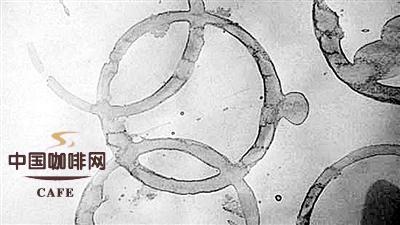Coffee Ring effect will be used in Biological Detection

When coffee is splashed on the table, pay a little attention to the imprint left by the coffee droplets after the evaporation of the liquid, you will find that the edge of the droplet forms a dark ring that is much darker than the middle area, which means that the concentration of small coffee particles deposited at the edge is much higher than that in the middle area. This phenomenon of uneven deposition is known as the coffee ring effect.
Not only coffee, but many solutions of small solid particles appear as a dark ring at the boundary after evaporation. A research team led by Professor Ho Zhiming, a member of the American Academy of Engineering and director of the Institute of Cell Control at the University of California, Los Angeles, proposes that this common phenomenon in life can be combined with biosensor technology to detect biomarkers in saliva, blood and other body fluids for medical diagnosis. However, to apply this phenomenon to biological testing, one must first find the smallest size limit at which the coffee ring effect occurs.
There is a size limit to the coffee ring effect because, as the droplet size decreases, the evaporation velocity of the droplet increases greatly, while the velocity of the solid particles in the droplet does not change much. If the droplet size is small enough, the droplet evaporation speed will be much higher than the solid particle movement speed, and the particle will not have enough time to settle into a ring structure before the droplet evaporation is complete. These particles, too late to move, are deposited almost uniformly over the entire area covered by the droplet rather than at the edge of the droplet. To find the size limit of the coffee ring effect, the researchers created a special lattice structure surface with adjacent cells coated with different coatings that have different hydrophilicity and hydrophobicity, that is, different positions on the surface have different abilities to retain liquids or repel liquids. With such a structure, droplets of a desired size can be formed on the surface.
The researchers then tried dissolving latex particles of different size in water, ranging from 20 nanometers to 100 nanometers in diameter, which is the size of small biomarker particles commonly detected by biosensors. Then they drop the solution of dissolved particles onto the surface of the prepared lattice, tilting the surface to allow excess liquid to slide off and form droplets of the desired diameter on the lattice of the hydrophilic surface. By gradually reducing the droplet size, the researchers found that for solutions containing small particles 100 nanometers in diameter, the coffee ring effect no longer appeared when the droplet size was reduced to nearly 10 microns (about one-tenth the diameter of a hair strand).
Dr. Huang Desheng, from the School of Mechanical and Aeronautical Engineering at the University of California, Los Angeles, who participated in the study, said that human blood or saliva contains a large number of micro-or nano-scale molecules or biological particles that can be deposited using the coffee ring effect and analyzed and quantified using related biological detection techniques. Knowing the smallest possible size at which the so-called coffee ring effect occurs can help minimize the biosensor size and enable a single chip to detect multiple biomarkers simultaneously on a small area.
"This detection technique also has the advantage that the whole detection process is very natural and only relies on the normal evaporation process." Dr Huang added: "This will make the whole testing facility very cheap and easy to manufacture. For remote areas without adequate medical facilities, such inexpensive and easily accessible medical devices will greatly assist in relevant medical tests." The researchers are now using the results to fine-tune parameters, hoping to get the best combination of experimental conditions for the coffee ring effect to be used for biological testing.
The results of this research have been published as a cover article in the American Journal of Physical Chemistry.
Important Notice :
前街咖啡 FrontStreet Coffee has moved to new addredd:
FrontStreet Coffee Address: 315,Donghua East Road,GuangZhou
Tel:020 38364473
- Prev

Identify whether it is the basic common sense of freshly ground coffee beans.
1. When you go to the place where you buy coffee, you will smell the aroma of coffee before you see it. This is how the aroma of coffee spreads easily. If it is an old coffee bean, the oil contained in the coffee will go bad instead of giving off a fragrance, so the aroma is a symbol of the quality of the coffee. The fresher the coffee, the better it tastes. If you want to enjoy delicious coffee, you must first buy it correctly and skillfully.
- Next

Edible cookies, coffee cups, edible coffee cups.
This Cookie Cup is an alternative coffee cup designed by Venezuelan designer Enrique Luis Sardi for Italian coffee company Lavazza. It is made of sugary starch and covered with pastry. It is just a cookie, but it takes into account the function of the cup. At afternoon tea time, do you drink coffee first or have a snack first? Let the glass decide for you. Drink first.
Related
- Detailed explanation of Jadeite planting Land in Panamanian Jadeite Manor introduction to the grading system of Jadeite competitive bidding, Red bid, Green bid and Rose Summer
- Story of Coffee planting in Brenka region of Costa Rica Stonehenge Manor anaerobic heavy honey treatment of flavor mouth
- What's on the barrel of Blue Mountain Coffee beans?
- Can American coffee also pull flowers? How to use hot American style to pull out a good-looking pattern?
- Can you make a cold extract with coffee beans? What is the right proportion for cold-extracted coffee formula?
- Indonesian PWN Gold Mandrine Coffee Origin Features Flavor How to Chong? Mandolin coffee is American.
- A brief introduction to the flavor characteristics of Brazilian yellow bourbon coffee beans
- What is the effect of different water quality on the flavor of cold-extracted coffee? What kind of water is best for brewing coffee?
- Why do you think of Rose Summer whenever you mention Panamanian coffee?
- Introduction to the characteristics of authentic blue mountain coffee bean producing areas? What is the CIB Coffee Authority in Jamaica?

